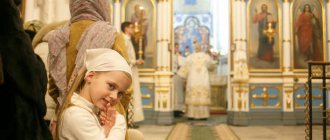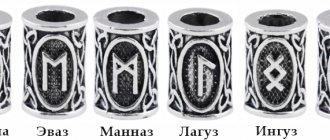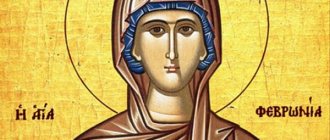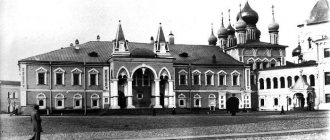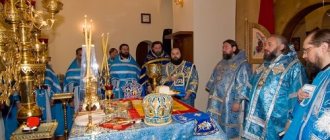Chiton (Greek χιτών, “clothing”) is the lower clothing of the ancient Greeks. The chiton had no sleeves and was usually a rectangular piece of wool or linen fabric (in the classical era, only actors wore chitons with sleeves).
In the Bible (in its Greek Septuagint translation, as well as in a number of other translations into European languages), the word “tunic” is translated into the Hebrew word “kutonet” (כתונת) (Exodus \ Shemot, chapter 28, v. 40), which means the genus Jewish men's and women's shirts; the tunic (kutonet) is part of the prescribed garment for priests and Levites (Exodus 28:40). Such a shirt with wrist-length sleeves was worn on a naked body.
In Rome there was an analogue of the chiton, which was worn in the same ways - the tunic.
Caryatid from the Erechtheion. London, British Museum. 421-407 BC
Auriga. Part of the bronze sculptural composition - the dedication of the Sicilian tyrants at Delphi. Delphi, Archaeological Museum. Around 470 BC
Cloth
First of all, the chiton is a common type of clothing among the ancient Greeks and Romans. It looked like a long shirt, but without sleeves. Only actors wore tunics with sleeves when performing in the theater. They were made from wool or linen.
Chitons were made for both men and women. The male version was made from a piece of fabric that was rectangular in shape, approximately 1 m wide and about 1.7 m long. This section was folded vertically in half, and then cleaved with special buckles in the shoulder area. A special garter was worn as a belt to support clothing. During military or sports exercises, one of the buckles was removed to provide greater freedom of movement.
The bottom of the robe had to be hemmed. This made a very big difference. For example, an unhemmed bottom was a sign that the owner of the chiton was in mourning or was a slave.
This is also the name of a costume made of thin fabric with side slits and sleeveless, in which dancers perform. Today it can be seen, for example, in ballet.
Women's tunic
Women's chiton was no different in design from men's, but a much larger number of ways to wear and belt it are known. Often, a belt emphasized not only the waist, but also the chest. Women's chitons were usually longer and wider than men's, which made it possible to achieve a wide variety of draperies.
Scheme for wearing a chiton
Scheme for wearing a chiton
Varieties
A chiton is clothing that, at first glance, was casual and ordinary. However, this is not quite true. Its length directly depended on the social status, as well as the age of the owner. Mostly among the inhabitants of Ancient Greece and the Roman Empire, the tunic reached to the knees.
Priests, politicians and important officials wore long tunics that reached their ankles while performing their duties. Soldiers and senior military personnel, on the contrary, wore a short version of this clothing - above the knees. This was due to the fact that in battle the fighters needed maximum freedom of movement. Also, a long chiton could create various interferences.
The workers, like the soldiers, wore shortened clothing, but it was passed only over one shoulder and was belted. One of the main differences between workers' tunics is the fabric itself from which it was made. Usually it was a rough and dense material, devoid of any frills.
Church of the Holy Apostles Peter and Paul
February 25, 2014 Deacon Sergiy Chechanichev
This image of Christ
–
The Savior
in a white tunic was painted by the Holy Russian Hieromartyr Metropolitan Seraphim (Chichagov)
The life of Lord Seraphim is extraordinary and amazing.
Metropolitan Seraphim (in the world Leonid Mikhailovich Chichagov), great-grandson of the famous admiral V.Ya. Chichagov, one of the first explorers of the Arctic Ocean, was born in 1856. First, Leonid was educated at the First St. Petersburg Classical Gymnasium, and then at the Corps of Pages, after which he was enrolled in the Preobrazhensky Regiment.
In 1879, Leonid Mikhailovich married Natalya Nikolaevna Dokhturova, the grandniece of General D.S. Dokhturov, hero of the Patriotic War of 1812.
In 1891, Leonid Mikhailovich, being thirty-six years old, left military service with the rank of colonel, deciding to choose a different path in life - the priesthood.
In 1895, having become a widower and leaving four daughters in the care of trusted people, Father Leonid entered the Trinity-Sergius Lavra, where on August 14, 1898 he became a monk with the name Seraphim.
Having become a priest, Fr. Leonid began compiling the “Chronicle of the Seraphim-Diveevsky Monastery,” which was the most significant work of his life. The Chronicle was published in 1896 and presented to Tsar Nicholas II. It was this circumstance that influenced the decision on the issue of glorifying St. Seraphim (of Sarov) as a saint.
Archbishop Seraphim met the revolution of 1917 in St. Petersburg. Having gone through revolutionary errors and a series of arrests, in 1928 Metropolitan Seraphim was appointed administrator of the St. Petersburg diocese.
It was precisely these times that the appearance of the image of Christ in a white tunic dates back to, not entirely canonical in its writing, but very attractive and stunning with its inner light.
Let us imagine a time of severe persecution of the Church of Christ, a time of torture, mockery, and executions. And in the midst of all this horror, Lord Seraphim foresees not the darkness of the Apocalypse, but that Transfiguration light that Christ showed on Mount Tabor to his disciples Peter, James and John. “And He was transfigured before them: and His face shone like the sun, and His clothes became white as light” (Matthew 17:2). This is the Light of the Resurrection of Christ from the dead. This is the light of our resurrection, the resurrection of the Orthodox faith on Russian soil.
The Metropolitan was arrested in the late autumn of 1937. What danger could a frail and completely sick old man, who was already 84 years old, pose to the authorities? However, the verdict was inexorable. They decided to kill him. On December 7, 1937, the NKVD troika decided to shoot Metropolitan Seraphim. On December 11, the sentence was carried out.
Shortly before his arrest, Metropolitan Seraphim said: “The Orthodox Church is now going through a time of testing. Whoever remains faithful to the Apostolic Church now will be saved. Many are now leaving the Church due to persecution, others are even betraying it. But it is well known from history that there were persecutions before, but they all ended in the triumph of Christianity. So it will be with this persecution. It will end and Orthodoxy will triumph again. Now many suffer for their faith, but this is gold that is purified in the spiritual crucible of trials. After this there will be as many holy martyrs who suffered for the faith of Christ as the entire history of Christianity cannot remember.”
Today we see how prophetic the words of the innocently murdered Lord turn out to be. Russia is again moving toward the light of the Christian faith, toward that light that the Hieromartyr Metropolitan Seraphim so deeply and soulfully embodied in this image of Christ.
St. Petersburg, 2000
Tags: Current topic, image of Christ
Robe of the Lord
Continuing to consider what the tunic means, we should also say about the Robe of the Lord. Christians know about it because the Gospel describes in detail how it appeared. According to legend, the Robe of the Lord, which is essentially a tunic, was given to one of the soldiers by lot after it was removed from Jesus Christ before his crucifixion.
However, there is a version that in addition to the tunic, Christ also had a robe, divided into parts, one of which is kept in the treasury of one of the monasteries in Iveria (the territory of present-day Georgia). It should be noted that there are several different traditions (Syrian, Armenian and Georgian) that do not agree with each other on what is considered a robe and what is a tunic. It is difficult to take sides in these conflicting versions, since it is not possible to verify them.
Because the Jewish priests had similar clothes
Old Testament priests had special clothes. According to the Holy Scriptures, God himself commanded the prophet Moses to sew special clothes for them - “for greatness and beauty.” To do this, it was necessary to take blue, purple and crimson fabric - wool or linen, and embroider them with gold.
The clothing of the Jewish priests consisted of a chiton - an undershirt that reached to the floor, an upper robe, an ephod covering the back and chest, a belt and a turban - a turban. On top of the ephod the high priest wore a breastplate decorated with precious stones.
Through the prophet Ezekiel, God commanded the priests to use vestments only for sacred ceremonies and to remove them before leaving the temple into the outer court, changing into everyday clothes (Ezek. 44:19).
This clothing to some extent became the prototype of the modern vestments of Orthodox priests. Nowadays, they change clothes in the same way, leaving their clothes in the temple.
Shellfish
When studying the meaning of the word “chiton”, you should definitely pay attention to armored mollusks. These underwater inhabitants belong to the class of marine mollusks. They are called "side-nervous" or "chitons". To date, about 1000 species of these underwater representatives are known. They reach sizes from 1 to 40 cm and vary greatly in their shape.
Chitons are inhabitants of almost all seas and oceans. They mainly live at shallow depths of up to 30 m, but there are representatives who live at a depth of 2,500 m, where there is very high pressure.
They have an oval body, completely covered on top with a shell consisting of 8 plates. The age of the chiton can be determined by the rings around the latter. Scientists claim that these are descendants of mollusks that lived millions of years ago and, in fact, have changed slightly.
These creatures stick to various objects, and their shell serves as a kind of shield from everyone who wants to feast on them. The main enemies of mollusks are fish, crabs, and starfish.
Exomis
Exomis, exomida (ancient Greek ἐξωμίς, from exo - outside, omos - shoulder) - in Ancient Greece, a piece of rough fabric (skin, skin), attached to the left shoulder, measuring approximately 2.3 by 1.40 meters. It can be called a subspecies of chiton. The exomis was fastened at the waist with a belt, and on the left shoulder with a tie, belt, fibula or agraph. The size and texture of the fabric reflected the status of the owner: coarse fabric without folds with an uneven or frayed hem was a sign of a slave, larger fabric with simple folds was a sign of a free man, a warrior. A cloak or animal skin could be worn on top. A short exomis (above the knees) was sometimes used as a loincloth.
Other meanings
Clothes and sea life aside, Heaton is a town in Britain. It is located next to Newcastle and is in fact a suburb of the latter. The town of Heaton is quite small. The bulk of the population consists of workers who work in factories located in the city and miners who extract coal in numerous mines.
In addition to the listed meanings, Heaton is an English surname. Among its representatives there are quite famous people: actors, musicians and athletes. Today, one of the most popular Heaton can be considered an actor from Britain - Charlie. He gained considerable popularity in the West, starring in various television series.
Each thing has its own symbol
In the attire of a priest, each item is given a separate meaning. For example, the hair shirt tunic, in which the monks-schema monks dress, symbolizes non-covetousness and during tonsure is called the “tunic of free poverty.”
Similar to the tunic, the surplice is worn by altar servers, readers and sextons; the surplice is a symbol of angelic purity and joy.
The deacon dresses in a surplice and puts on an orarion, meaning the wings of an angel - a long strip of material with crosses and embroidery “Holy, Holy, Holy.” It is believed that the orarion appeared from a towel-ubrus, which the Jews used to sign to say “Amen”.
The priest's clothes are a man's long dress down to his toes - the cassock comes in different cuts - with a wrap or with buttons. This is the only vestment that the priest can wear outside the temple. On top of the cassock they put on a cassock - a spacious black vestment with long sleeves - below the palms. The cross that priests wear over their clothes should remind them that every Christian must confess Christ before everyone.
During the Liturgy, the priest puts on a surplice, which has the same meaning as a surplice.
A phelonion or chasuble is put on the cassock - a long, wide garment without sleeves, with hard and high shoulders, which signifies loyalty to God and the scarlet robe that was put on the Savior during His suffering. It is known that the Apostle Paul already wore a veil.
The priest puts on the remaining vestments over the phelonion. These are armbands - armlets, which are fastened with laces, symbolizing the bonds of Christ; stole - a long strip of material with six crosses around the neck, symbolizing service to Christ; a belt symbolizing readiness to serve; a legguard, which is a sign of the spiritual sword - the weapon of a priest, which is a rectangular plate with a cross. It points to the Gospel and is worn in the same place where warriors previously carried a sword.
In the Russian Orthodox Church, clergy have the right to wear clothes in gold, white, red, blue, purple, black and green - depending on the service being performed and the church calendar. The symbolism of color is considered unsettled and differs in the Russian Orthodox Church in Russia and abroad.
